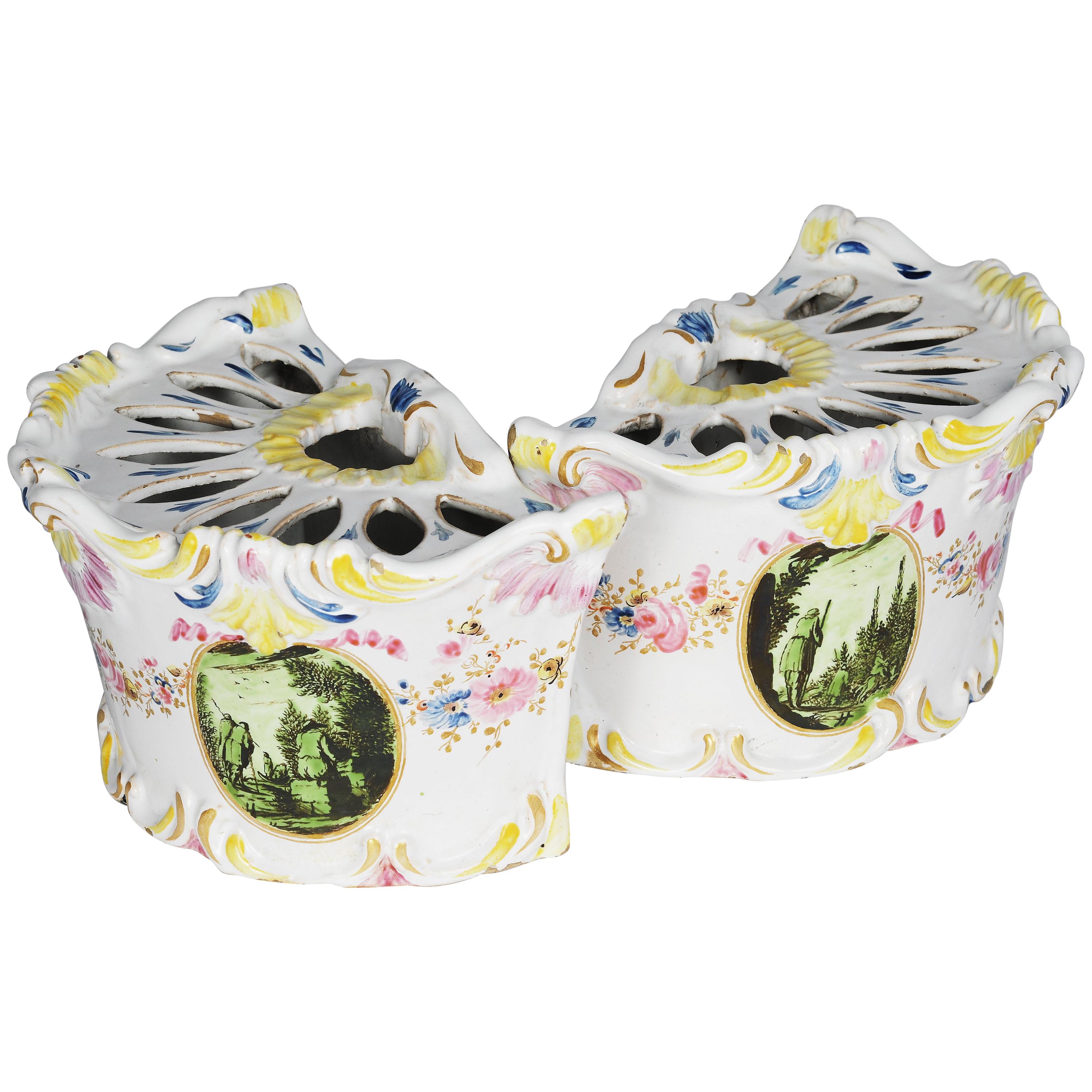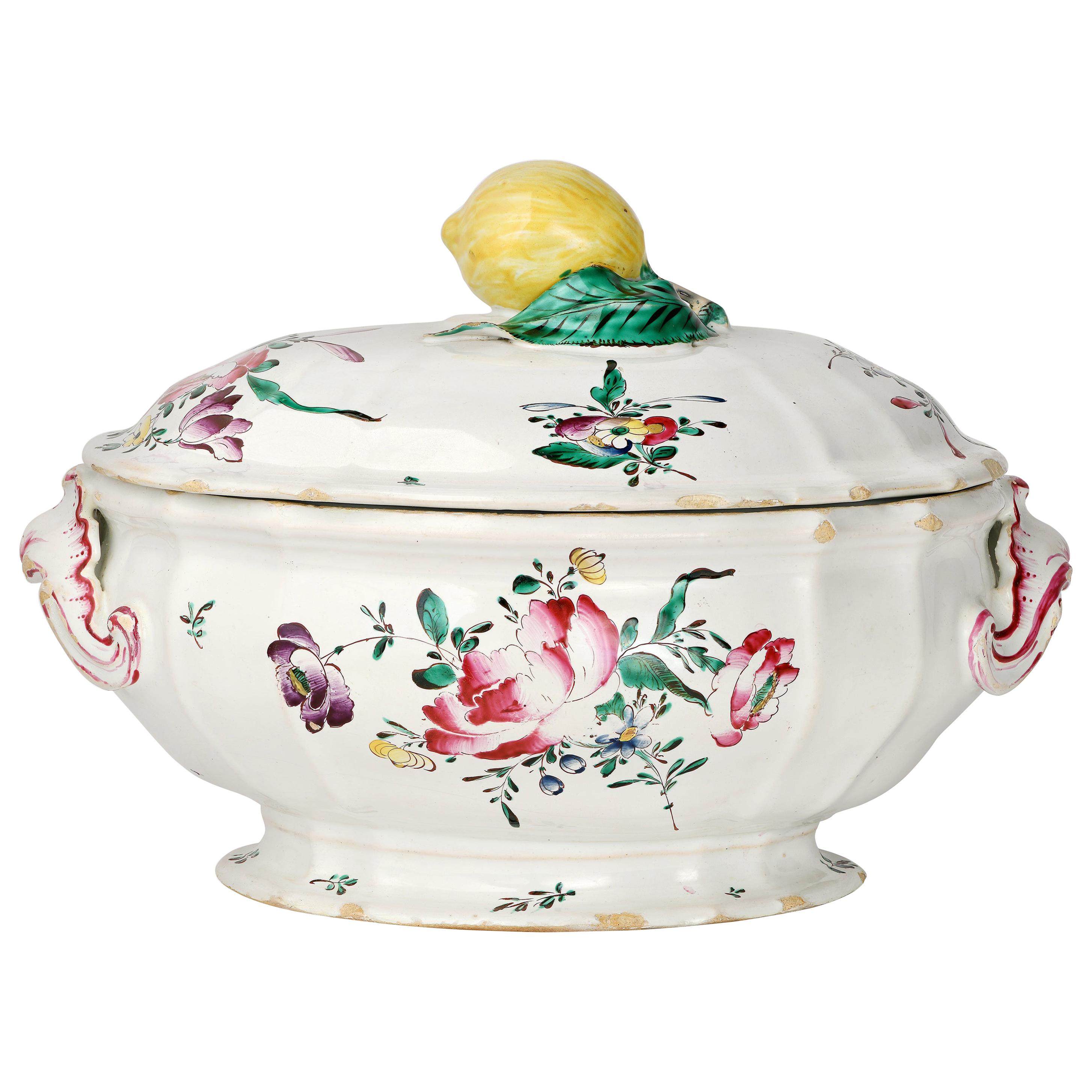Items Similar to Ancient Maiolica Coffee Set “Barbotine” Decoration Milan, 1770- 1780
Video Loading
Want more images or videos?
Request additional images or videos from the seller
1 of 22
Ancient Maiolica Coffee Set “Barbotine” Decoration Milan, 1770- 1780
About the Item
Coffee assortment with “barbotine” decoration
Manufacture of Pasquale Rubati or Felice Clerici
Milan, 1770- 1780
Maiolica polychrome decorated “a piccolo fuoco” (third fire).
They measure:
Coffee pot: 7.48 x 5.90 x 6.10 in (19 x 15 x 15.5 cm); weight 1.2 lb (574 g).
Sugar bowl: 2.40 x 4.92 x 3.74 in (9.5 x 12.5 x 9.5 cm); weight 0.5 (223 g).
Cup with saucer: the cup 1.77 x 3.14 in (cm 4.5 x 8) and the saucer diameter 4.92 in (12.5 cm); weight 0.4 lb (186 g).
The coffee pot bears under the base the label of the famous exhibition of the Poldi Pezzoli Museum of 1964.
State of conservation: the coffee pot has the addition of a grip lid and a covered chip on the edge; the body is affected by a crack that runs from the mouth along the body and around the belly of the container. The sugar bowl has two restored chips on the edge of the lid and two minor chips visible at the edge of the bowl. The cup and saucer are intact.
The maiolica and porcelain factories of the eighteenth century mainly belonged to great royal or noble families who made the manufacture of ceramic works a sign of prestige. In Milan, under Maria Teresa of Austria, the time period witnessed a real opening to new industrialists who, by virtue of the privatizations granted by the government, assumed a real business risk, giving life, albeit not without conflict, to flourishing factories and to production which was among the most elegant and most requested at the moment and which still today remains object of collection. In Milan in the 18th century, two maiolica factories were active. The first was that of Felice Clerici, from 1745, and the second was opened by Pasquale Rubati in 1756, in competition with Felice, for whom he had been a worker. Upon Rubati's death, in 1796, the enterprise was continued for a few years under his son Carlo.
The series of objects is decorated with flowers in relief, a subject referred to in the inventories as “alla barbottina”, to indicate the technique used to make it. The decorative motif features some many petalled flowers in relief, partly connected by little manganese branches with thin cobalt blue and copper green leaves and small insects scattered over the rest of the surface.
The ornamentation originates from Chinese blanc de Chine decorations in relief or in any case from motifs from Canton. This style became one of the most sought-after decorations produced in Milan during the late eighteenth-century.
The enamel is thin and blue whereas the polychromy is full and shows a skilful use of the various shades of green and the presence of "ferraccia" red. The flower corollas are obtained by applying thin spheres of very diluted clay, the “barbottina”, then shaped and left to dry.
The coffee pot, with an enlarged, rotund, ribbed pyriform body, has a griffin beak pourer and a shaped handle, decorated in iron red; the lid is slightly raised and surmounted by a button knob (added during restoration.
The oval sugar bowl, with a poded and swollen profile, has a coherent lid surmounted by a pear-shaped knob.
The assortment is completed with an oriental-style bowl, without handle, but accompanied by a round saucer with a high brim and a ring foot.
These are some of the most typical forms of production of the Clerici factory in Milan, even if, at least in the initial period, they were all also adopted by the competing manufacture of Pasquale Rubati. The latter boasted of having used this very decoration: "not found in any other factory", as confirmed by some well-known pieces that bear his signature (G. Gregorietti, Maioliche di Lodi, Milan and Pavia, exhibition catalog, Poldi Pezzoli Museum, Milan 1964, n. 386), while those known under the Clerici brand are few and probably replacement pieces (G. Gregorietti, Maioliche di Lodi, Milano e Pavia, exhibition catalogue, Museo Poldi Pezzoli, Milano 1964 n. 388).
Various examples of comparison are known in public and private collections. Of particular interest is the comparison with the large group of "alla barbottina" works preserved in the Museum of Applied Art of the Castello Sforzesco in Milan (R. Ausenda, curated by, Musei e Gallerie di Milano. Museo d’Arti Applicate. Le ceramiche, Tomo secondo, Milano 2001 pp. 372-384, nn. 360-362.)
Bibliography:
G. Gregorietti, Maioliche di Lodi, Milano e Pavia, catalogo della mostra Museo Poldi Pezzoli, Milano 1964, nn. 390 the coffee pot; e 389-392 comparisons;
R. Ausenda, a cura di, Musei e Gallerie di Milano. Museo d’Arti Applicate. Le ceramiche, Tomo secondo, Milano 2001, pp. 372-384, nn. 360-362.
- Creator:Pasquale Rubati (Manufacturer)
- Dimensions:Height: 7.49 in (19 cm)Width: 5.91 in (15 cm)Depth: 6.11 in (15.5 cm)
- Sold As:Set of 3
- Style:Rococo (Of the Period)
- Materials and Techniques:Maiolica,Glazed
- Place of Origin:
- Period:1770-1779
- Date of Manufacture:1770-1780
- Condition:Repaired: The coffee pot has the addition of a grip lid. Minor losses. Minor fading. The coffee pot has the addition of a grip lid and a covered chip on the edge; the body is affected by a crack that runs from the mouth along the body and around the belly of the container. The sugar bowl has two restored chips on the edge of the lid.
- Seller Location:Milano, IT
- Reference Number:1stDibs: LU4352227685212
About the Seller
4.3
Vetted Seller
These experienced sellers undergo a comprehensive evaluation by our team of in-house experts.
Established in 1860
1stDibs seller since 2018
19 sales on 1stDibs
Typical response time: 6 hours
Associations
International Confederation of Art and Antique Dealers' Associations
- ShippingRetrieving quote...Ships From: Milano, Italy
- Return PolicyA return for this item may be initiated within 14 days of delivery.
More From This SellerView All
- Ancient Maiolica Plates Pasquale Rubati, Milan Circa 1770-1780By Pasquale RubatiLocated in Milano, ITFive oval maiolica dishes with pierced edge Manufacture of Pasquale Rubati Milan, 1770-1780 Three small oval dishes 10.23 in x 7.67 in (26 cm x 19.5 cm) Two large oval dishes 10.82 in x 8.85 in (27.5 x 22.5 cm) lb 3.5 (kg 1.8) State of conservation: intact The five dishes of different sizes have an oval shape, a mixtilinear edge and a molded polylobed shape with a surface enriched with a relief weave motif extending to the brim and forming a perforated basket...Category
Antique 1770s Italian Rococo Ceramics
MaterialsMaiolica
- Ancient Maiolica Cup, Rubati Manufacture, Milan, Circa 1770 - 1780By Pasquale RubatiLocated in Milano, ITSick cup Pasquale Rubati Manufacture Milan, Circa 1770 - 1780 Maiolica decorated in polychrome “a piccolo fuoco” (third fire) It measures: h 2.36 x 7.4 x 7.87 (h 6 x 19 x 20 cm) ...Category
Antique 1770s Italian Rococo Ceramics
MaterialsMaiolica
- Ancient Italian Maiolica Tureen, Rubati Manufacture, Milan, circa 1770-1780By Pasquale RubatiLocated in Milano, ITMaiolica tureen Pasquale Rubati Manufacture Milan, circa 1770 - 1780 Maiolica polychrome decorated “a piccolo fuoco” (third fire). It measures 6.69 in x 11,02 x 8.26 (17 x 28 x ...Category
Antique 1770s Italian Rococo Ceramics
MaterialsMaiolica
- Ancient Maiolica Flower Pot Pasquale Rubati Factory, Milan Circa 1770By Pasquale RubatiLocated in Milano, ITMaiolica flower pot “a mezzaluna” decorated with tulip Pasquale Rubati Factory Milan, circa 1770. Measures: 4.7 in x 4.7 in x 8.6 in 12 cm x 12...Category
Antique 1770s Italian Rococo Ceramics
MaterialsMaiolica
- Pair of Ancient Italian Maiolica Flower Pots Milan, Rubati Factory, 1770 circaBy Pasquale RubatiLocated in Milano, ITMaiolica flower pot “a mezzaluna” decorated with trompe l’oeil Pasquale Rubati Factory Milan, circa 1770 Measures: each 4.7 in (cm 12) x 5 in (c...Category
Antique 1770s Italian Rococo Ceramics
MaterialsMaiolica
- Italian Maiolica Ancient Tureen, Lodi, 1770-1780By Antonio FerrettiLocated in Milano, ITMaiolica tureen Antonio Ferretti Manufacture Lodi, circa 1770-1780 Maiolica polychrome decorated “a piccolo fuoco” (third fire). It measures 9.05 x 12.59 x 9.05 in (23 x 32 x 23 cm) ...Category
Antique 1770s Italian Rococo Ceramics
MaterialsMaiolica
You May Also Like
- First Period Worcester Coffee Cup Porcelain Finely Hand Painted, circa 1770By 1st Period Worcester Dr. WallLocated in Lincoln, LincolnshireThis is a rare first period (or Dr. Wall) Worcester Coffee Cup, with a distinctive hand painted pattern, made of porcelain and dating to the 18th century, circa 1770. The cup is well potted with a grooved loop handle This delightful early Worcester Cup...Category
Antique 18th Century English George III Ceramics
MaterialsPorcelain
- Turquoise Maiolica Italian Albarello Late, 1800sLocated in Roma, ITThis beautiful turquoise maiolica patterned Italian albarello (late 1800s early 1900s) was found in Palazzo Torlogna in Rome. Albarelli were ancient storag...Category
Antique Early 19th Century Italian Greco Roman Ceramics
MaterialsMaiolica, Ceramic
- A Deruta Maiolica Dish Early 16th CenturyLocated in Firenze, ITSHIPPING POLICY: No additional costs will be added to this order. Shipping costs will be totally covered by the seller (customs duties included). The centre painted with archaic de...Category
Antique 16th Century Italian Renaissance Ceramics
MaterialsMaiolica
- A Large Italian Maiolica Charger, 19th CenturyLocated in CABA, ARMaiolica chargers are large, decorative ceramic plates that are part of the broader tradition of Maiolica pottery, a type of tin-glazed earthenware produced in Italy since the Renais...Category
Antique 19th Century Italian Renaissance Revival Ceramics
MaterialsCeramic
- Teruel (Aragon) - Spanish Maiolica Mortar, 17th centuryLocated in DELFT, NLCeramic mortar produced at the Teruel pottery workshops in the 17th century. It has a truncated cone shape with three handles and a pourer. It is tin-...Category
Antique 17th Century Spanish Baroque Ceramics
MaterialsMaiolica
- Set of Three Mid-Century French Hand Painted Ceramic Barbotine Fruit Wall PlatesBy LongchampLocated in Dallas, TXDecorate a kitchen wall or shelf with this suite of 3 colorful antique majolica plates. Sculpted in France circa 1920 in the manner of Longchamp, each porcelain plate is decorated wi...Category
Early 20th Century French Ceramics
MaterialsCeramic, Majolica





